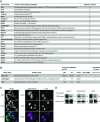The RNA-Protein Interactome of Differentiated Kidney Tubular Epithelial Cells
- PMID: 30867249
- PMCID: PMC6442340
- DOI: 10.1681/ASN.2018090914
The RNA-Protein Interactome of Differentiated Kidney Tubular Epithelial Cells
Erratum in
-
Correction: The RNA-Protein Interactome of Differentiated Kidney Tubular Epithelial Cells.J Am Soc Nephrol. 2025 Apr 11;36(7):1456. doi: 10.1681/ASN.0000000737. J Am Soc Nephrol. 2025. PMID: 40215110 Free PMC article. No abstract available.
Abstract
Background: RNA-binding proteins (RBPs) are fundamental regulators of cellular biology that affect all steps in the generation and processing of RNA molecules. Recent evidence suggests that regulation of RBPs that modulate both RNA stability and translation may have a profound effect on the proteome. However, regulation of RBPs in clinically relevant experimental conditions has not been studied systematically.
Methods: We used RNA interactome capture, a method for the global identification of RBPs to characterize the global RNA-binding proteome (RBPome) associated with polyA-tailed RNA species in murine ciliated epithelial cells of the inner medullary collecting duct. To study regulation of RBPs in a clinically relevant condition, we analyzed hypoxia-associated changes of the RBPome.
Results: We identified >1000 RBPs that had been previously found using other systems. In addition, we found a number of novel RBPs not identified by previous screens using mouse or human cells, suggesting that these proteins may be specific RBPs in differentiated kidney epithelial cells. We also found quantitative differences in RBP-binding to mRNA that were associated with hypoxia versus normoxia.
Conclusions: These findings demonstrate the regulation of RBPs through environmental stimuli and provide insight into the biology of hypoxia-response signaling in epithelial cells in the kidney. A repository of the RBPome and proteome in kidney tubular epithelial cells, derived from our findings, is freely accessible online, and may contribute to a better understanding of the role of RNA-protein interactions in kidney tubular epithelial cells, including the response of these cells to hypoxia.
Keywords: HIF; RBP; RNA-binding protein; cilia; hypoxia; tubule cells.
Copyright © 2019 by the American Society of Nephrology.
Figures






Similar articles
-
Systemic pharmacological treatments for chronic plaque psoriasis: a network meta-analysis.Cochrane Database Syst Rev. 2021 Apr 19;4(4):CD011535. doi: 10.1002/14651858.CD011535.pub4. Cochrane Database Syst Rev. 2021. Update in: Cochrane Database Syst Rev. 2022 May 23;5:CD011535. doi: 10.1002/14651858.CD011535.pub5. PMID: 33871055 Free PMC article. Updated.
-
Behavioral interventions to reduce risk for sexual transmission of HIV among men who have sex with men.Cochrane Database Syst Rev. 2008 Jul 16;(3):CD001230. doi: 10.1002/14651858.CD001230.pub2. Cochrane Database Syst Rev. 2008. PMID: 18646068
-
Systemic pharmacological treatments for chronic plaque psoriasis: a network meta-analysis.Cochrane Database Syst Rev. 2017 Dec 22;12(12):CD011535. doi: 10.1002/14651858.CD011535.pub2. Cochrane Database Syst Rev. 2017. Update in: Cochrane Database Syst Rev. 2020 Jan 9;1:CD011535. doi: 10.1002/14651858.CD011535.pub3. PMID: 29271481 Free PMC article. Updated.
-
Signs and symptoms to determine if a patient presenting in primary care or hospital outpatient settings has COVID-19.Cochrane Database Syst Rev. 2022 May 20;5(5):CD013665. doi: 10.1002/14651858.CD013665.pub3. Cochrane Database Syst Rev. 2022. PMID: 35593186 Free PMC article.
-
Taxane monotherapy regimens for the treatment of recurrent epithelial ovarian cancer.Cochrane Database Syst Rev. 2022 Jul 12;7(7):CD008766. doi: 10.1002/14651858.CD008766.pub3. Cochrane Database Syst Rev. 2022. PMID: 35866378 Free PMC article.
Cited by
-
A protein-RNA interaction atlas of the ribosome biogenesis factor AATF.Sci Rep. 2019 Jul 30;9(1):11071. doi: 10.1038/s41598-019-47552-3. Sci Rep. 2019. PMID: 31363146 Free PMC article.
-
Proteomic analysis of murine kidney proximal tubule sub-segment derived cell lines reveals preferences in mitochondrial pathway activity.J Proteomics. 2023 Oct 30;289:104998. doi: 10.1016/j.jprot.2023.104998. Epub 2023 Aug 30. J Proteomics. 2023. PMID: 37657718 Free PMC article.
-
The DNA binding high mobility group box protein family functionally binds RNA.Wiley Interdiscip Rev RNA. 2023 Sep-Oct;14(5):e1778. doi: 10.1002/wrna.1778. Epub 2023 Jan 16. Wiley Interdiscip Rev RNA. 2023. PMID: 36646476 Free PMC article. Review.
-
AATF/Che-1-An RNA Binding Protein at the Nexus of DNA Damage Response and Ribosome Biogenesis.Front Oncol. 2020 Jun 10;10:919. doi: 10.3389/fonc.2020.00919. eCollection 2020. Front Oncol. 2020. PMID: 32587828 Free PMC article. Review.
-
Nucleolin Regulates Pulmonary Artery Smooth Muscle Cell Proliferation under Hypoxia by Modulating miRNA Expression.Cells. 2023 Mar 6;12(5):817. doi: 10.3390/cells12050817. Cells. 2023. PMID: 36899956 Free PMC article.
References
-
- Hentze MW, Castello A, Schwarzl T, Preiss T: A brave new world of RNA-binding proteins. Nat Rev Mol Cell Biol 19: 327–341, 2018 - PubMed
-
- Dutertre M, Vagner S: DNA-Damage Response RNA-Binding Proteins (DDRBPs): Perspectives from a new class of proteins and their RNA targets. J Mol Biol 429: 3139–3145, 2017 - PubMed
-
- Milek M, Landthaler M: Systematic detection of poly(A)+ RNA-interacting proteins and their differential binding. Methods Mol Biol 1649: 405–417, 2018 - PubMed
Publication types
MeSH terms
Substances
LinkOut - more resources
Full Text Sources
Molecular Biology Databases

